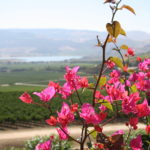Sustainable Sicily, the pursuit of a new model..

Together with around 70 other journalists from Italy and the rest of Europe we gathered in
Villa Igiea in Palermo in October, to learn more about Sicilian wine and their focus on
sustainability. The event was promoted by the Consortium for the Protection of DOC Sicilia
Wines. On the first evening the president of Consorzio di Tutela Vini Doc Sicilia, Antonio Rallo,
told us that Sicily has become the leading wine region for organic wine farming in the welcoming
conference. Together with the foundation Assovini and several wine producers like Donnafugata,
COS and Planeta they have thus created the Fondazione SOStain Sicilia.
Laurent Bernard de La Gatinais, the President of Assovini Sicilia and Alberto Tasca, President of
SOStain were also present at the conference, as well as several researchers and ministers, and last
but not least, the regional manager of Unicredit, who has done a lot to support this project.
“Sicily’s organic vineyard is the largest in Italy, amounting to 30,084 hectares. This is three times
the size of Veneto’s organic vineyard, twice the size of Tuscany’s and almost twice the size of
Apulia’s organic vineyard. Sicily is therefore the largest organic wine-growing area in Italy,
accounting for 34% of the Italian organic surface area. 22% of Sicilian producers now producing
organic grapes: this means that more than one in five has chosen this path and we can only be
proud of this. A satisfaction sealed by numbers, which are remarkable: in 2018 the number of
bottles of organic wine reached 8,293,085, to grow to 10,328,089 bottles in 2019. Last year there
was a drop, which was widely expected, but entirely in line with the slowdown caused by the
pandemic: organic bottled wine amounted to 9,807,003, which corresponds to 10.82% of the total
number of bottles produced in 2020, i.e., 90,594,310. Overall, organic bottled wine in 2020 is 18.25%
higher than in 2018. This year, with data updated to 30 September, Sicily produced a total of
9,182,800 hectolitres of organic bottles, which corresponds to 12.9% of the bottles in
2021:71,169,733, again on 30th September” -Antonio Rallo

What does the SOStain label mean?
-Sustainable vineyard management
-Prohibition of chemical weeding
-Biodiversity protection
-Use of eco-friendly materials
-Local raw materials
-Using VIVA indicators
-Energy-efficient technologies
-Bottle weight reduction
-Transparency of communication
-Limit on residue content in wines
Consorzio di Tutela Vini DOC Sicilia
The Sicilia Controlled Designation of Origin was officially recognised on 22nd November 2011 by a
Decree of the Italian Ministry of Agriculture, Food and Forestry Policies, which at the same time
also approved its production specifications. As set out in the specifications, the area of production
of grapes intended for the production of wines with the “Sicilia”, Controlled Designation of
Origin includes the entire administrative territory of the Region of Sicily.
The following year, 2012, marks the founding year of the Consortium for the Protection of DOC
Sicilia Wines: the winegrowers, winemakers and bottlers who were in favour of the recognition of
the Controlled Denomination of Origin decided to establish the Consortium, a reality that would not
only give them a voice, but that would concretely succeed in enhancing and safeguarding the
island’s wine production. The Consortium was formed with a very precise aim: to protect, promote,
enhance, inform the consumer, and look after the general interests of DOC “Sicilia”.

It consists of 23 DOC og 1 DOCG:
DOC:
- Alcamo
- Contea di Sclafani
- Contessa Entellina
- Delia Nivolelli
- Eloro
- Erice
- Etna
- Faro
- Malvasia delle Lipari
- Mamertino di Milazzo o Mamertino
- Marsala
- Menfi
- Monreale
- Pantelleria
- Noto
- Riesi
- Salaparuta
- Sambuca di Sicilia
- Santa Margherita di Belice
- Sciacca
- Sicilia
- Siracusa
- Vittoria
DOCG:
- Cerasuolo di Vittoria
2021 vintage
Consorzio di Tutela Vini Doc Sicilia: Precipitation was mainly concentrated in winter, particularly
in February and March, followed by a rather dry spring, with no unfavourable climatic events such
as particularly strong sirocco winds or frost. The flowering and fruit setting phases took place in the
best possible way, thanks to temperatures in line with the average of the last few years: the peak of
heat recorded at the end of June was compensated for by the drop in temperature in July, which
ensured the normal vegetative cycle of the plant. According to the Consortium’s forecasts, 2021 is
expected to be more generous than 2020, with a 10-15% higher harvest. The harvest
begins in early August and will follow the ripening periods of the different grape varieties in the
various territories.
Filippo Paladino, vice-president of the Consorzio di Tutela Vini Doc Sicilia elaborates: “As far as
ripening and harvesting are concerned, we are on average with last season. The first grapes to be
harvested are those of Pinot Grigio, followed by Chardonnay, especially in the uplands area, and
then the hills. After the first ten days of August, we expect to harvest Moscato and Sauvignon blanc
and after the middle of the month, we will continue with the autochthonous varieties: Grillo,
Zibibbo, Insolia and Grecanico. With regard to the reds, we plan to start harvesting around mid-
August with the international Merlot and Syrah and then continue with Nero d’Avola, Perricone
And Cabernet”.
During the 4 technical tastings of over 200 labels during these days, the focus was on Grillo and
Nero d`Avola. The following wines stood out from the crowd.

Grillo
Casa Grazia Zahara 2020: Slightly complex nose with yellow fruits, floral notes, minerals, and a hint
of smoke. Acidic and fresh taste, dry and structured finish. A well balanced and concentrated wine.
Planeta Terebinto 2020: Fruity nose with yellow fruits, citrus and some minerality. Fruity also in the
mouth, vibrant acidity, dry and slightly structured in the aftertaste. A tasty and well-balanced wine.
Cusumano Shamaris Tenuta Monte Pietroso 2020: Intense and alluring aromas of yellow fruit,
citrus and minerals. It is rich in taste, fruity, good acidity and has a long finish. Well balanced.
Caruso & Minini Naturalemente Bio 2020: Opens with yellow fruits, floral notes, minerals and
citrus. It continues with a dry and slightly structured taste, good acidity, and balance. Long
aftertaste.
Donnafugata Sur Sur 2020: Vibrant nose with subdued notes of apple and pear, floral notes and
minerals. A rounded and fruity taste with good acidity and balance. A classic and pleasant Grillo.
Fondo Antico Grillo Parlante 2020: Big nose with yellow fruits, peach, citrus, and minerals. Rich in
taste, fruity with good acidity, long and balanced aftertaste.
Intorcia Vignemie 2020: Alluring and fruity nose, yellow fruits, apple, citrus, and flowers. Fruity
also on the palate, good acidity, dry and somewhat structured aftertaste. A rounded and nice wine.
Vaccaro Luna Grillo 2020: Fresh and fruity nose, yellow fruits, herbs and minerals. Good fruit in
the mouth, as well as acidity, a nice balance to a slightly structured aftertaste. A good wine!
Settesoli Mandrarossa Bertolino Soprano 2018: Very fruity aromas, apple, yellow fruit, floral notes
and minerals. It is tasty and fruity, dry with good acidity, well balanced. A very nice wine,
concentrated.
Baglio ORO Guardiani Di Aralto 2018: Fruity nose with citrus, apples and minerals. It is rich in
taste, has a good acidity and a nice structure all through to the end. Well balanced.
Nero d`Avola
Tenute Orestiadi Nero d`Avola 2020: Dark fruit, forest berries and spices on the nose. Fruity and
rich taste, juicy and dry with a structured and a long aftertaste. A well-balanced wine, young and
promising.
Colosi Nero d`Avola 2020: Dark fruit, forest berries, herbs and spices on the nose. Its fruity with a
good body, long, intense, and structured aftertaste. A well balanced and good wine.
Fondo Antico Nenè 2019: Intense and spicy nose with forest berries, blueberries, plum, a hint of
wood and minerals. Intense and spicy also in the mouth, dry, long, and concentrated wine. A good
wine with a rich taste.
Catalano Catalano Viticoltori 2019: Dark berries, spices, herbs, and woody notes on the nose. It is
rich on the palate, fruity, juicy, well balanced with a long aftertaste.
Feudo Arancio Nero d` Avola 2019: Dark berries on the nose, blueberry, raspberry, spices, and some
light notes of barrel. It is fruity on the palate, spicy, good acidity, long and dry aftertaste. A well
balanced wine.
Montedidio Real Academia 2018: Dark berries, spices, herbs, red bell pepper and wood on the nose.
Fruity taste, rich and concentrated, well balanced, and long aftertaste.
Baglio del Cristo Lu Patri 2018: Dark berries on the nose, herbs, spices, and wood. It is fruity and
intense in the mouth, well balanced, long and dry aftertaste.
Vini Tola Black Label 2017: Dark Forest berries, spices and wood on the nose. It is fruity, tasty with
a good body, long and structured aftertaste. A classic and very well-balanced Nero d`Avola.
Vaccaro Luna Nero d`Avola 2020: Fruity nose with dark berries, forest fruit and spices. Fruity also
on the palate, rounded, good acidity, some spices in a structured finish. Very well balanced.
Feudo Arancio Hedonis Riserva 2015: Dark fruit, forest berries, spices. and herbs on the nose. Fruity
taste, slightly developed, good structure and a long aftertaste.

Mona Haugen-Kind
Mona Haugen-Kind is a Norwegian sommelier, winejournalist, wine judge.
Editor of wine magazine Vin&Brennevin www.vinbrennevin.no
and Norway`s leading website about wine and travel www.vinhona.com
She travels the world to find exciting wines to write about.